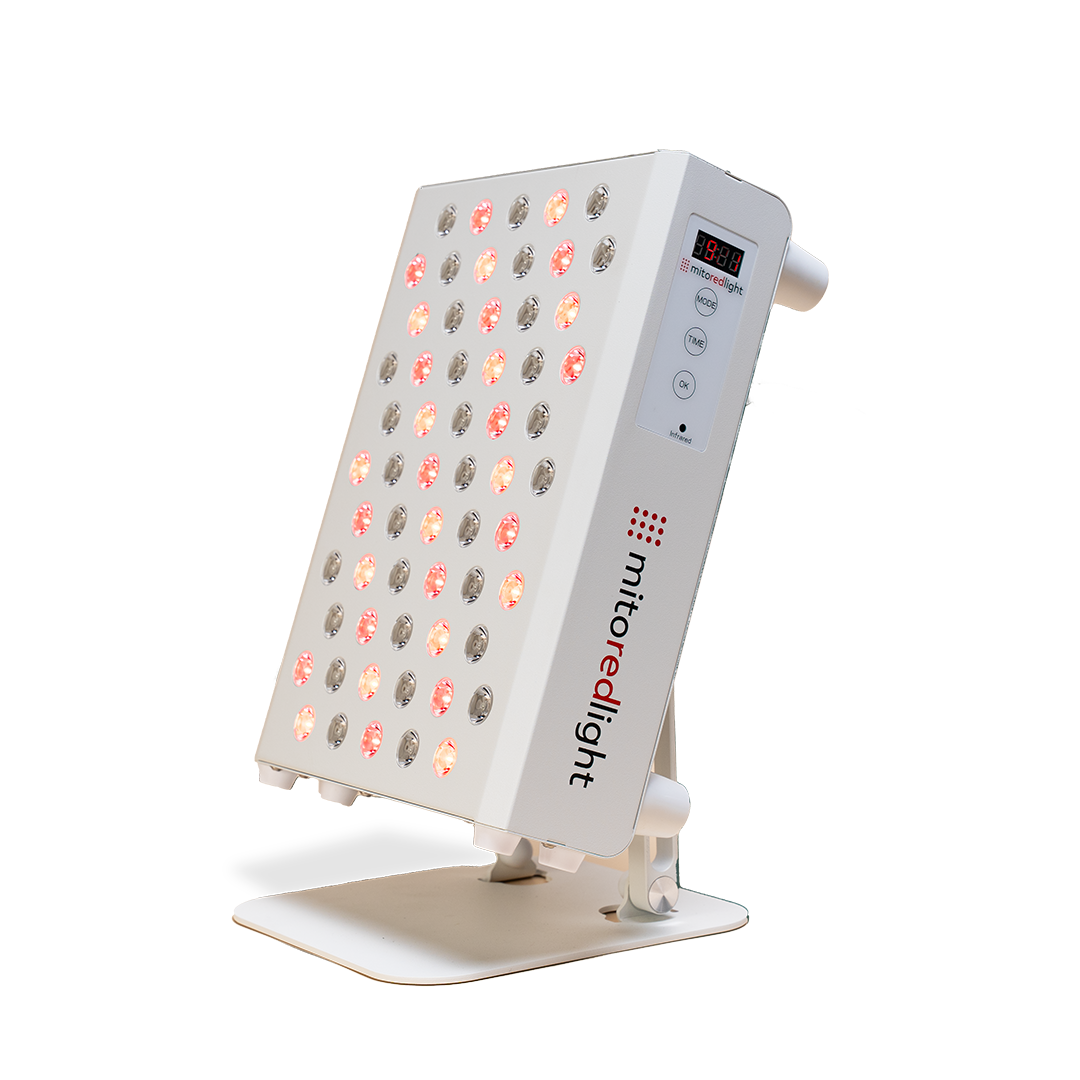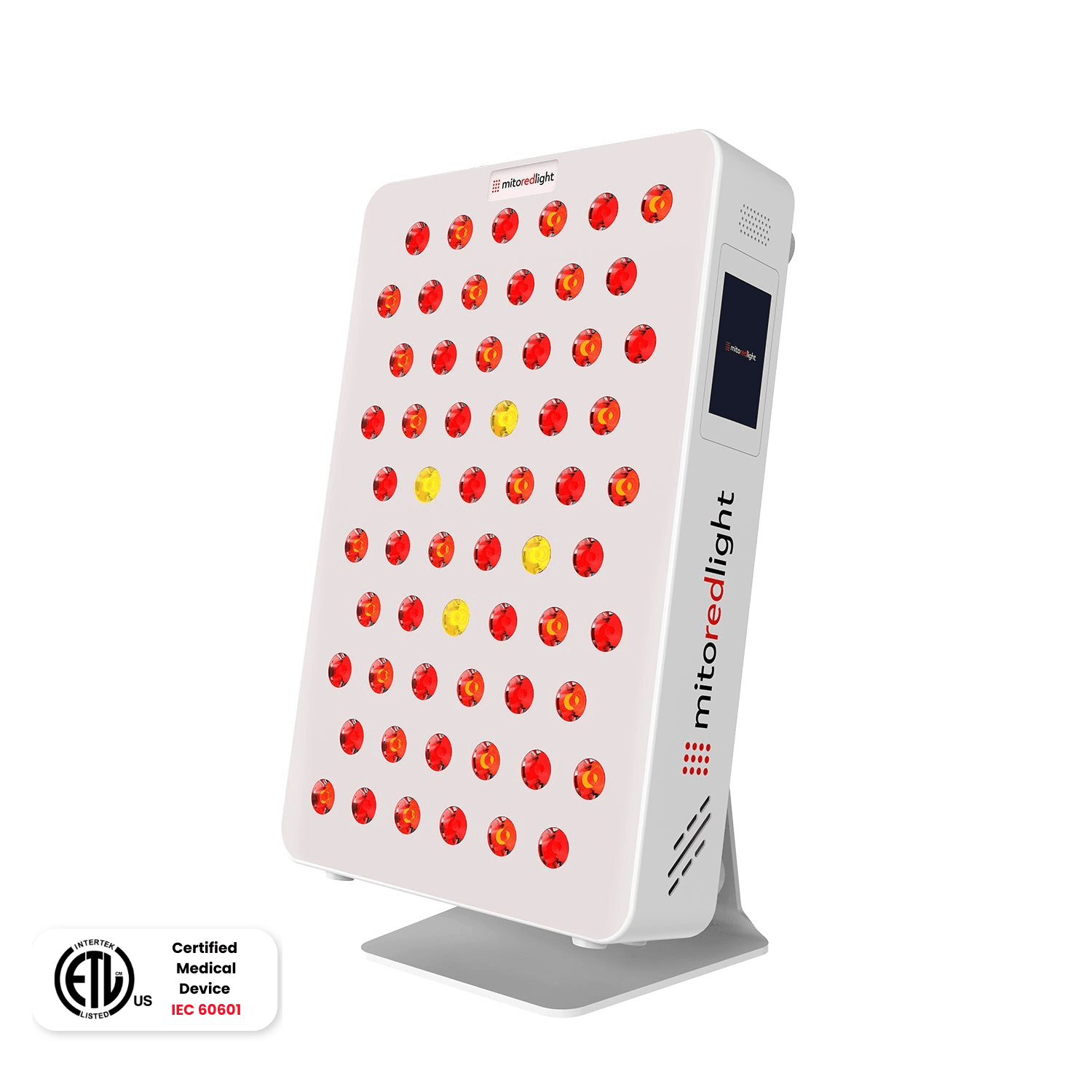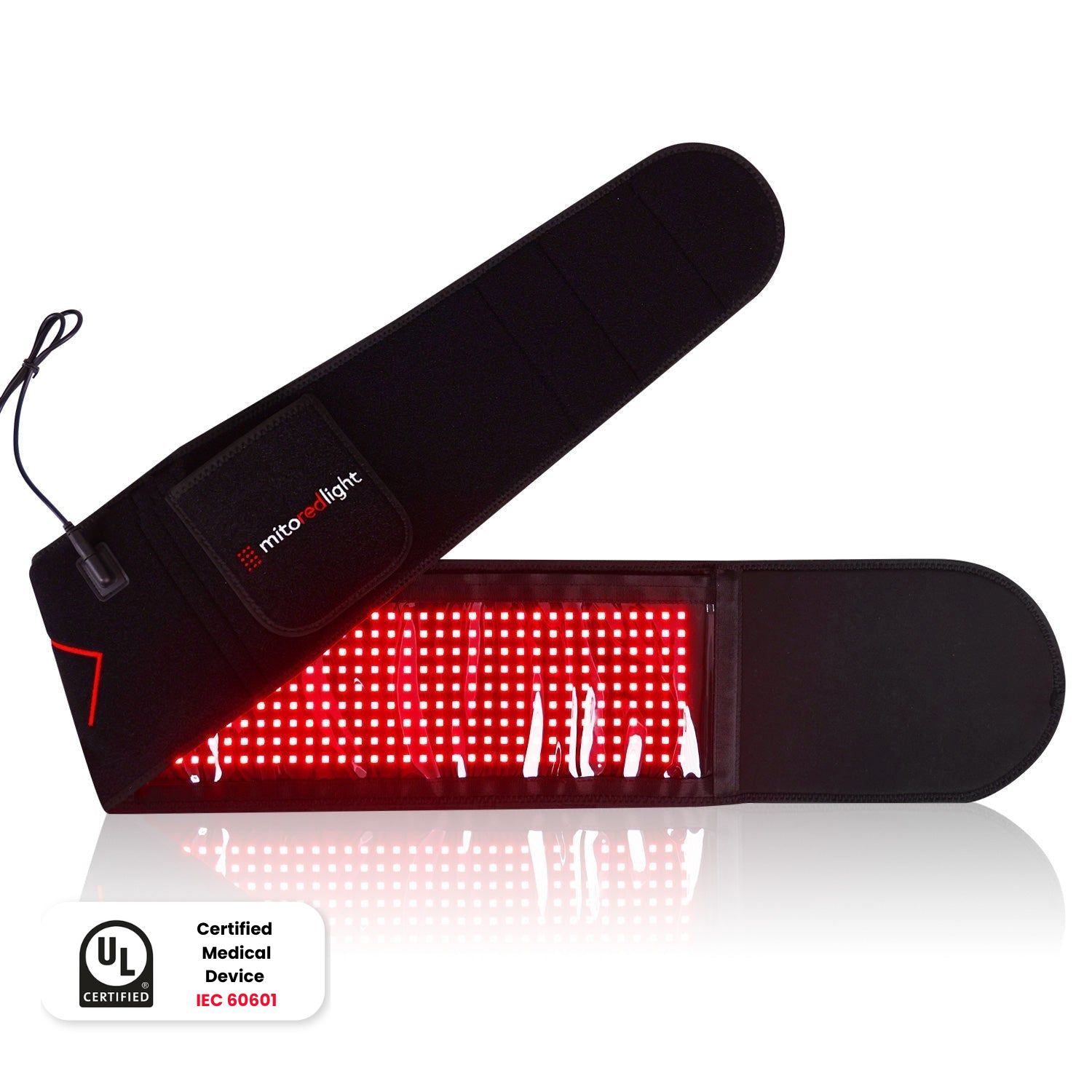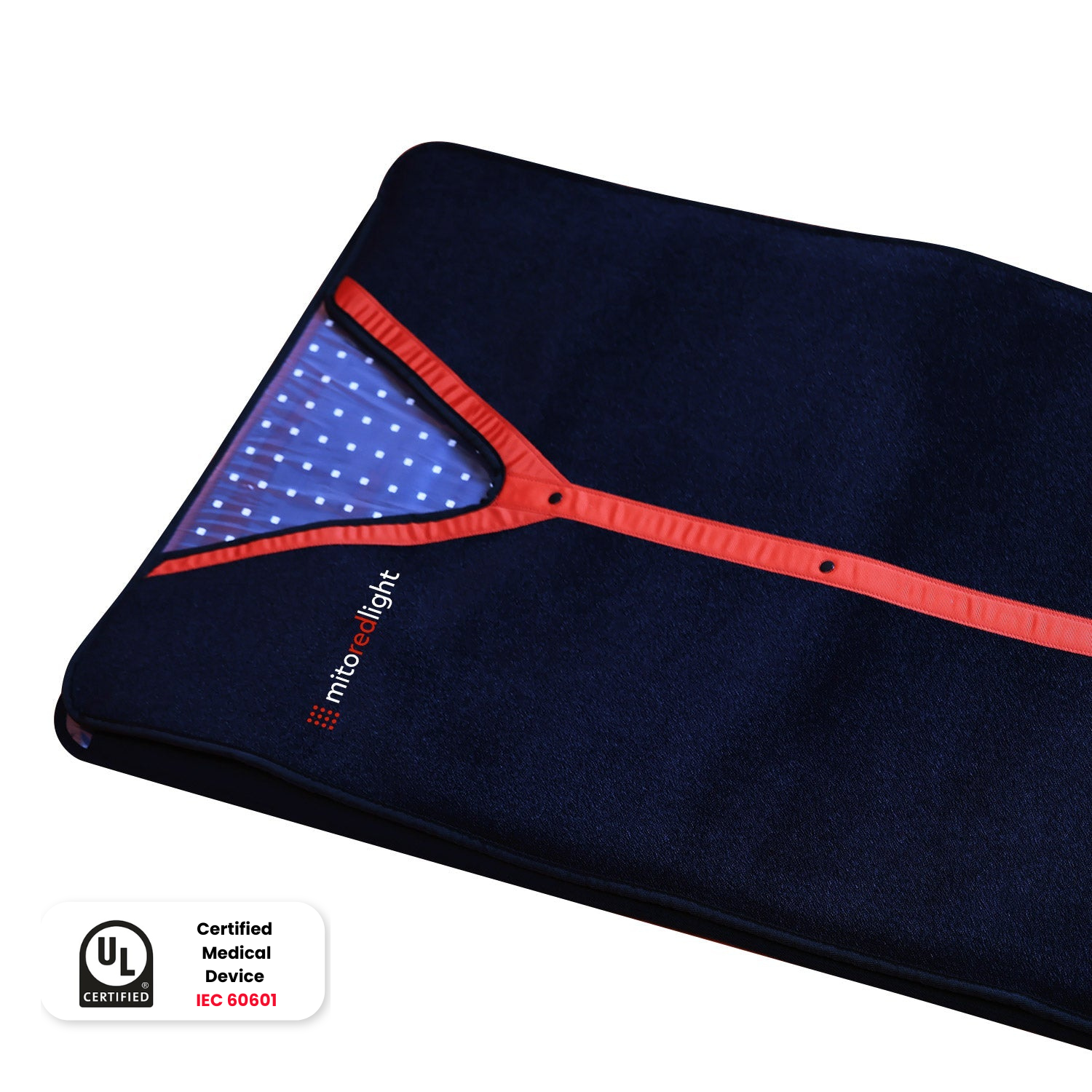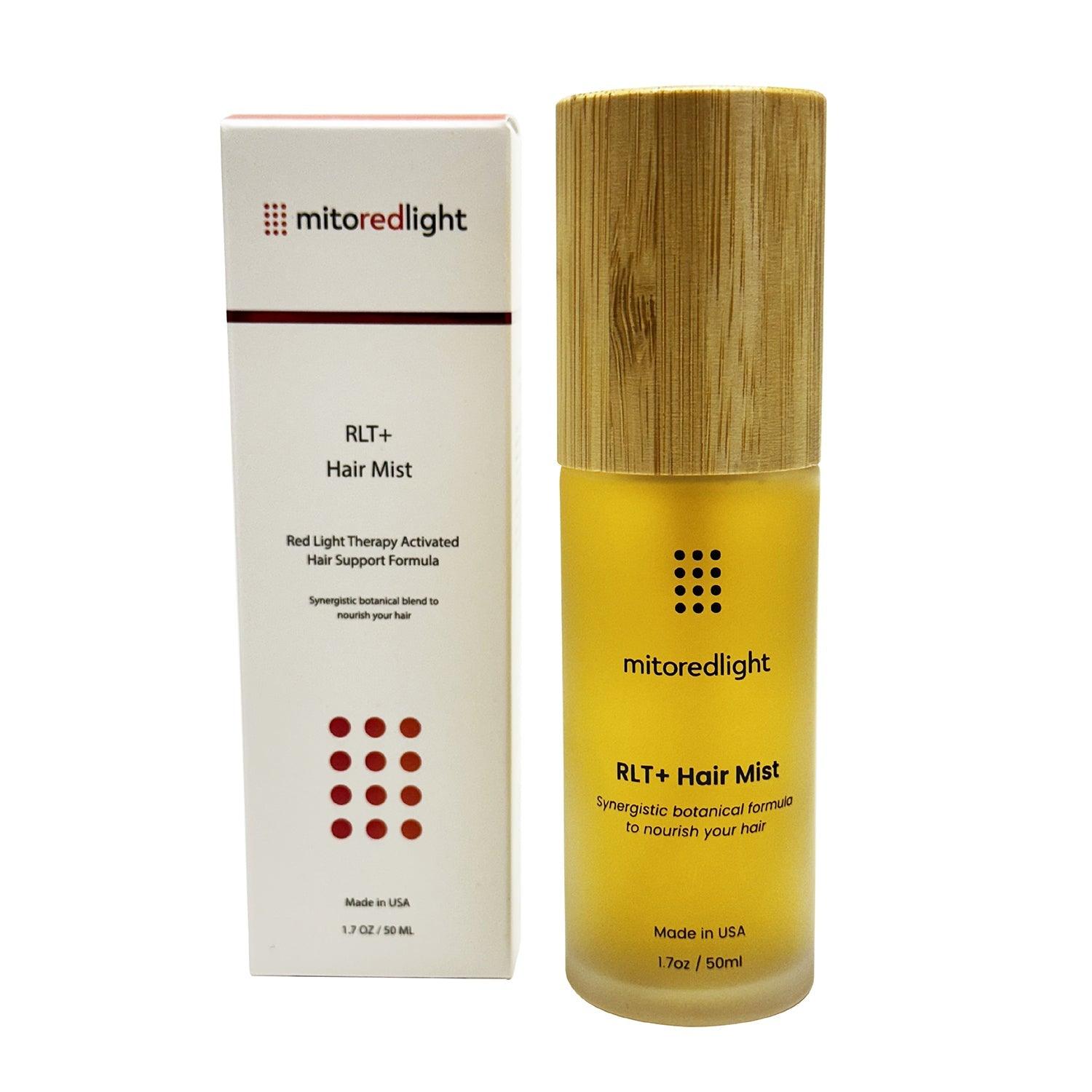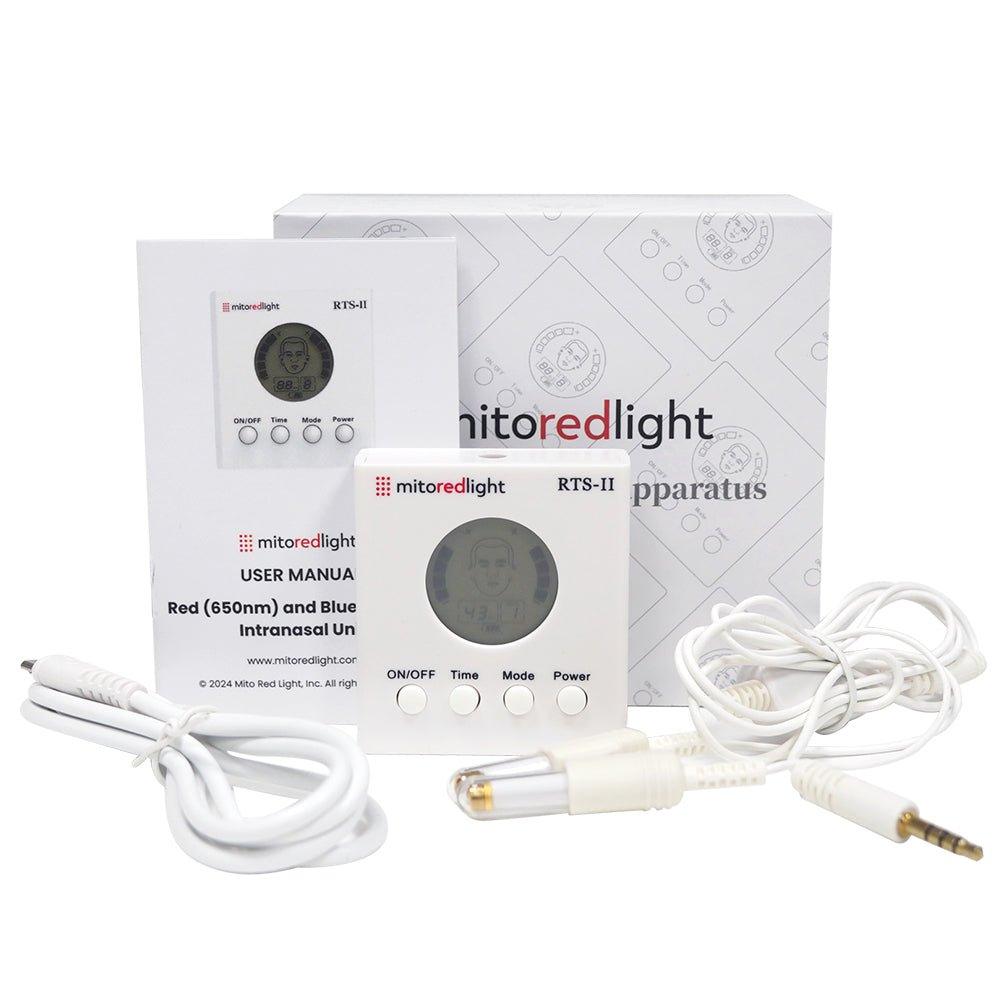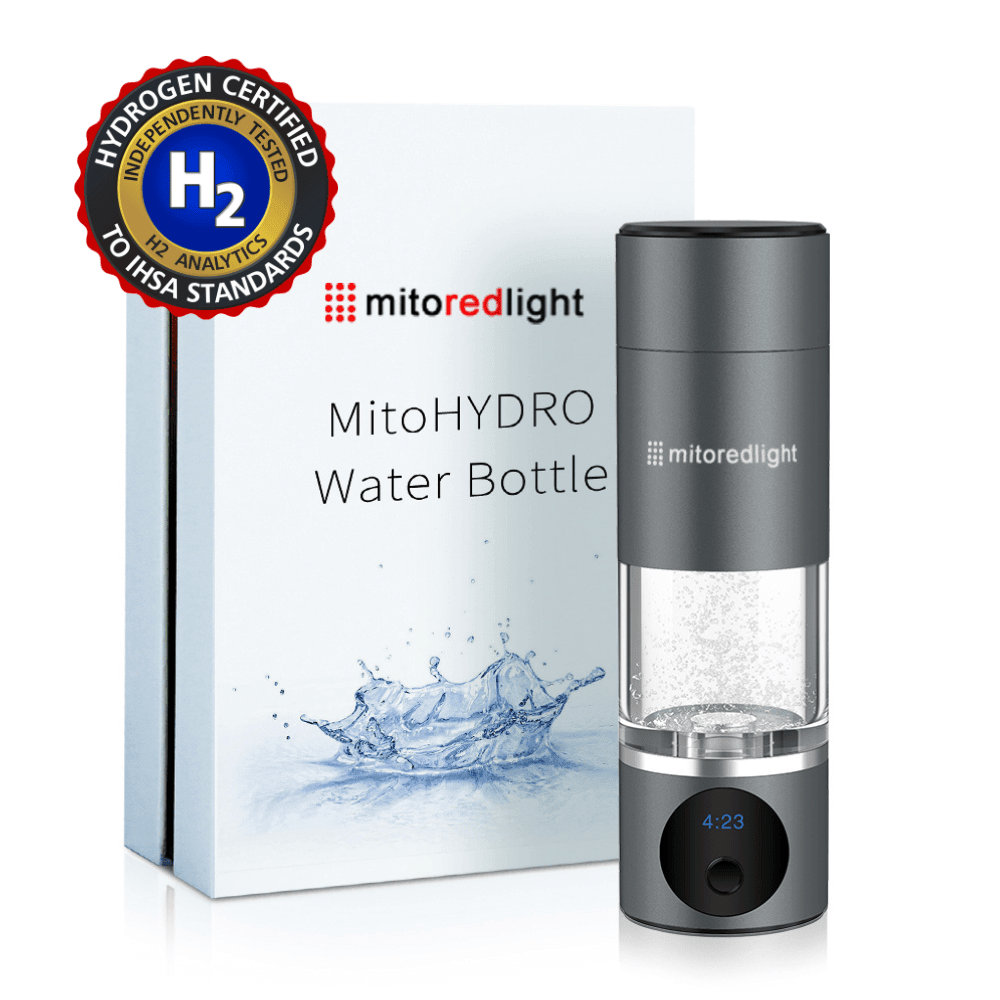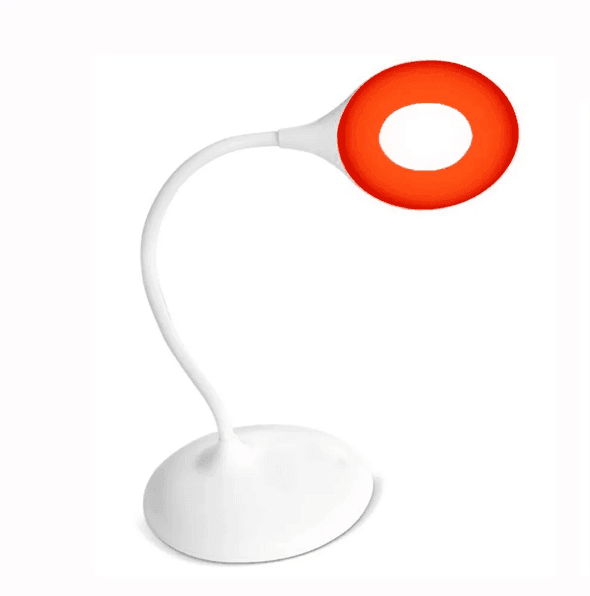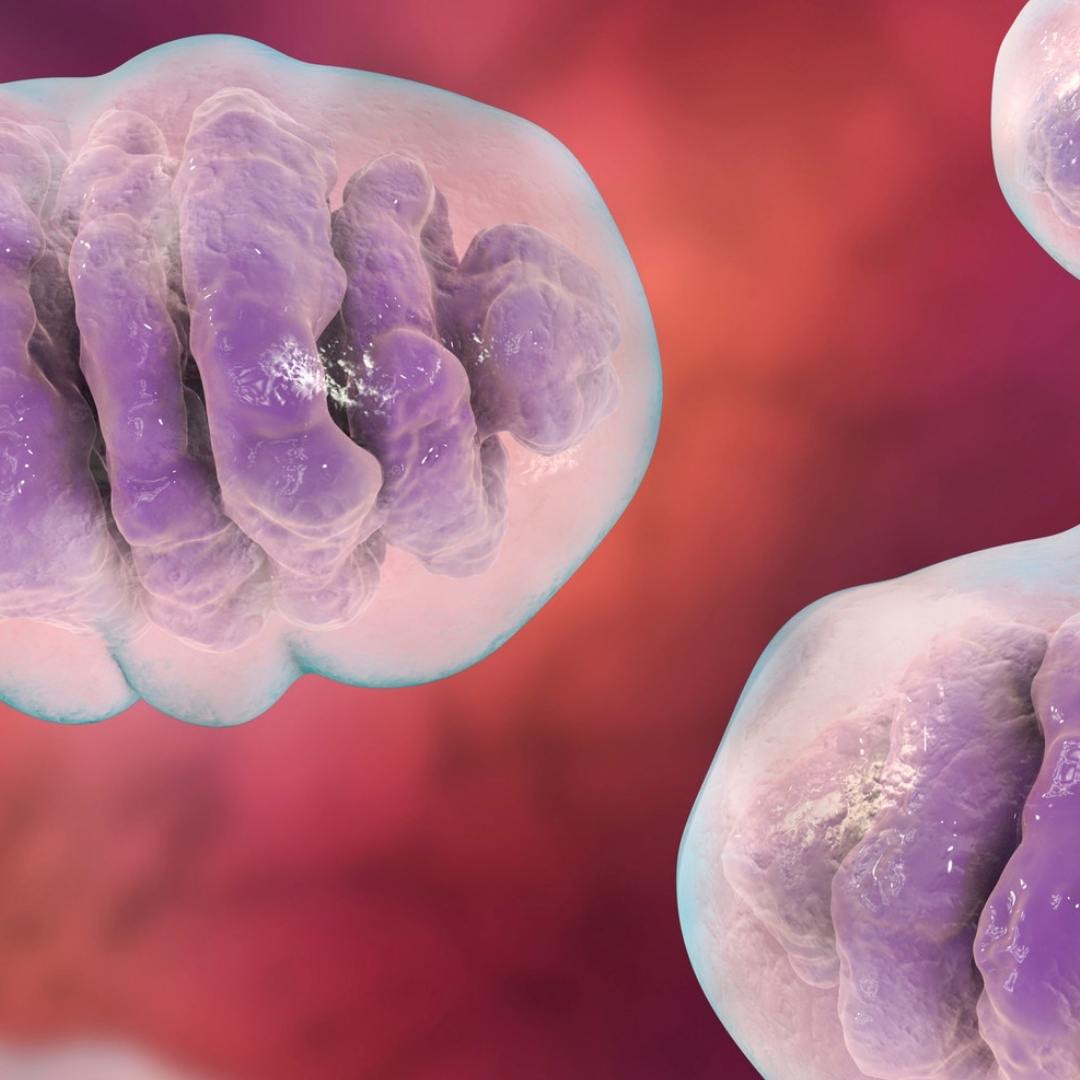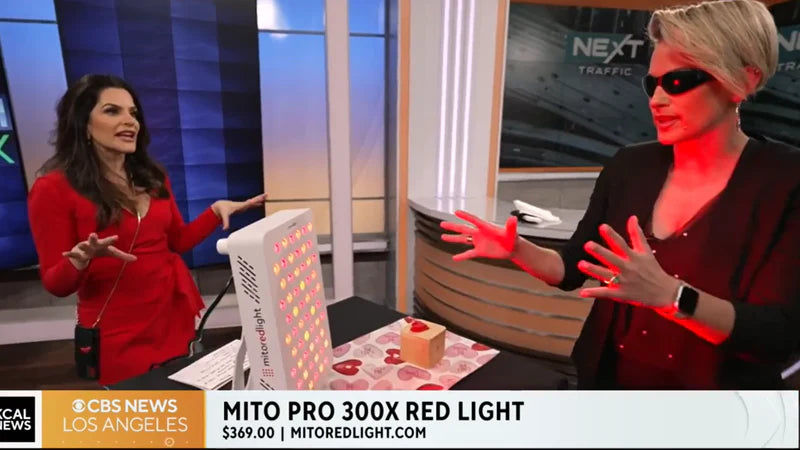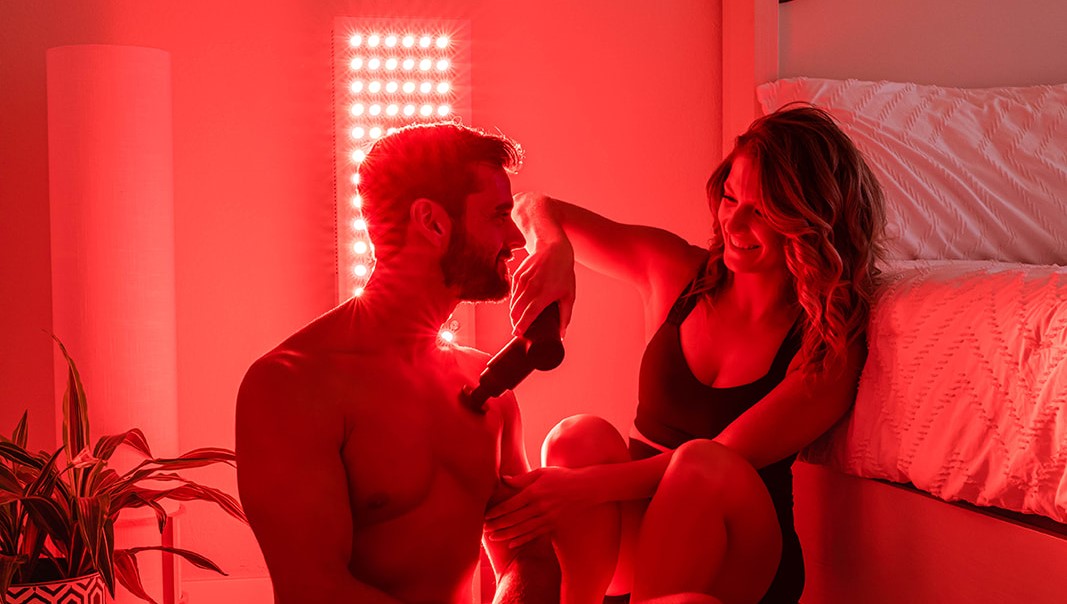Introduction
Red light therapy (RLT) has become a popular beauty and wellness ritual for helping skin look smoother, brighter, and more radiant. By using specific wavelengths of light in the red and near-infrared range, many people notice a more refreshed, even, and youthful-looking complexion over time.
MitoAURA Activate + Amplify Serum is formulated as a cosmetic companion to these light-based routines. It includes ingredients that are compatible with light exposure and are chosen to support the appearance, feel, and visible quality of the skin. In this article, we’ll walk through the key ingredients in MitoAURA, how they complement red light therapy from a cosmetic standpoint, and highlight published research that helps explain why they’re interesting in skincare.
Important: MitoAURA Activate + Amplify is a cosmetic skincare product, not a drug. It is not intended to diagnose, treat, cure, or prevent any disease or to affect the structure or function of the body. Any studies referenced are provided to describe ingredient properties in general, not to claim that this specific product has been clinically tested or produces identical results.
Red Light Therapy and Skin’s Appearance: A Quick Primer
Red (around 630–660 nm) and near-infrared (around 800–850 nm) wavelengths are used in many cosmetic LED devices. These wavelengths can reach into the upper layers of the skin, where they are widely used for beauty purposes such as:
-
Helping skin look smoother and more refined
-
Softening the appearance of fine lines and wrinkles
-
Improving the look of elasticity and bounce
-
Enhancing overall radiance and glow
Clinical and preclinical studies on LED light have reported visible improvements in the appearance of wrinkles, skin elasticity, and overall texture after regular use of red and near-infrared light. For example, combination LED protocols using 633 nm and 830 nm have been associated with smoother-looking skin and improved elasticity in cosmetic evaluations.¹ ²
RLT-compatible skincare is meant to support these cosmetic outcomes by:
-
Hydrating skin so it looks plump and dewy
-
Providing antioxidants to help defend against everyday environmental stressors
-
Supporting a more even, uniform skin surface so light can interact more evenly
MitoAURA is designed to be used before (and optionally after) red light sessions to help create an ideal cosmetic environment: hydrated, comfortable, and primed for that post-light glow.

Photoreactive Superfood: Spirulina Platensis Extract
Spirulina is a blue-green algae (cyanobacteria) rich in pigment-proteins such as phycocyanin. These pigments can interact with visible light in interesting ways. In laboratory settings, certain spirulina pigments absorb shorter-wavelength light and re-emit it at slightly longer red wavelengths, a phenomenon known as a “Stokes shift.” This optical behavior is one reason spirulina is being explored in light-responsive cosmetic formulas.
From a skincare perspective, spirulina extracts are valued for:
-
Antioxidant support, helping defend the skin’s surface from free radicals generated by everyday environmental exposure
-
Helping reduce the look of dullness and fatigue in the skin
-
Supporting a more radiant, even-looking complexion over time³
In MitoAURA, Spirulina Platensis Extract functions as a light-harmonizing antioxidant. Under light exposure (whether from everyday ambient light or dedicated red light sessions), it helps support a luminous, “lit-from-within” look while offering antioxidant protection to help maintain a fresher appearance.
Blue Antioxidant Pigment: Methylthioninium Chloride (Methylene Blue)
Methylene blue (MB) is a vivid blue pigment that has attracted cosmetic interest due to its powerful antioxidant behavior in skin models. Research on human skin cells and 3D skin equivalents suggests that methylene blue:
-
Helps protect against visible signs of oxidative stress
-
Supports a smoother, firmer-looking skin surface
-
May improve the look of hydration and plumpness with consistent use⁴ ⁵
Because methylene blue strongly absorbs red light, it is an especially intriguing pigment to pair with red light routines. In a cosmetic context, this interaction:
-
Can visually enhance the appearance of skin under red light
-
Contributes to a more vibrant, revitalized look post-treatment
-
Supports a balanced environment for skin that is regularly exposed to light and other daily stressors
In MitoAURA, methylene blue is included at low, cosmetic-appropriate levels. Its primary role is to act as a targeted antioxidant pigment that helps skin look smoother, more supple, and more energized, especially when used in a red-light-focused skincare ritual.
Lipid-Soluble Vitamin C: Tetrahexyldecyl Ascorbate
Vitamin C is a cornerstone ingredient in modern skincare, and MitoAURA uses an advanced, lipid-soluble form called Tetrahexyldecyl Ascorbate (THD Ascorbate). Unlike traditional water-soluble vitamin C, THD is:
-
Oil-soluble, allowing it to blend well into lipid-rich skin environments
-
More chemically stable in cosmetic formulations
-
Able to gradually convert to active ascorbic acid within the skin⁶ ⁷
From a cosmetic perspective, vitamin C derivatives like THD:
-
Help visibly brighten the complexion
-
Diminish the look of uneven tone and dark spots over time
-
Support the appearance of firm, smooth skin by helping keep collagen-rich skin looking healthy and resilient
When paired with red light routines:
-
Red light is used cosmetically to improve the appearance of texture and elasticity
-
Vitamin C provides antioxidant support and helps skin look more even and luminous
In short, THD Ascorbate in MitoAURA acts as a radiance and firmness enhancer: it supports more even-looking tone and complements the smoother, brighter appearance many people seek from red light therapy.
Firming Peptide: Palmitoyl Hexapeptide-12
Peptides are short chains of amino acids that can help “coach” skin to look and behave more youthfully from a cosmetic standpoint. Palmitoyl Hexapeptide-12 is an elastin-inspired peptide sometimes referred to as a “spring fragment,” because its amino acid sequence mimics part of skin’s natural elastic matrix.
In cosmetic studies, this type of peptide has been associated with:⁸
-
A firmer, more elastic-looking skin surface
-
Improved skin tone and texture
-
A reduction in the visible depth of fine lines and wrinkles with consistent use
It is often categorized as a matrikine, meaning it is modeled after natural fragments of the extracellular matrix that can signal skin to maintain a more youthful appearance.
Within MitoAURA:
-
Palmitoyl Hexapeptide-12 helps support a plumper, more resilient look
-
It pairs well with red light routines that are used to soften the look of wrinkles
-
Together, the light and peptide-rich serum work from complementary angles to help skin appear smoother and more supported
Think of this peptide as a firmness coach that works alongside your red light device’s cosmetic effects.

Light-Responsive Marine Ferments: Plankton Extract & Thermus thermophilus Ferment
MitoAURA also features marine-derived ingredients that bring advanced biotechnology into everyday skincare.
Plankton Extract
“Plankton Extract” is a broad term that typically refers to bioactive materials derived from microscopic marine organisms or microalgae. In cosmetic formulations, plankton-based ingredients are often used for:
-
Helping skin look more refreshed and less tired
-
Supporting a smoother, more even-looking complexion
-
Providing antioxidant and environmental defense benefits
Some plankton-derived complexes (including Lumenzyme™) are positioned around light-responsive or “light-activated” behavior, where visible light exposure is used to help support the look of skin exposed to environmental stressors such as UV, heat, and pollution. In practice, this translates into:
-
Skin that looks more even-toned over time
-
A complexion that appears brighter and more uniform
-
A supported, more resilient appearance, especially in sun-exposed areas⁹
In the context of a red light routine, plankton extract in MitoAURA is best thought of as a marine skin-revitalizer that complements the visual benefits of light by targeting visible dullness and fatigue.
Thermus thermophilus Ferment
Thermus thermophilus ferment is derived from a heat-loving microorganism found near hydrothermal vents and other high-temperature environments. In cosmetics, it is often described as an extremozyme-rich marine ferment with:
-
Antioxidant properties, helping neutralize free radicals generated by everyday environmental exposure
-
Support for the skin’s barrier function, helping it feel smoother and better hydrated
-
Benefits for skin that looks stressed, dry, or exposed to heat and light¹⁰ ¹¹
Cosmetic ingredient reviews and patents on Thermus thermophilus ferment (including versions marketed under names like Venuceane™) report improvements in:
-
The appearance of firmness and elasticity
-
Perceived smoothness and moisturization
-
Skin’s visible resilience under simulated heat or light exposure¹²
In MitoAURA, Thermus thermophilus ferment is included to serve as a heat-responsive resilience builder. During light-based beauty routines, when the skin’s surface may gently warm, this ferment is designed to support:
-
A more comfortable, hydrated feel
-
A complexion that looks calm yet energized
-
A smoother, more supple appearance over time
Together, plankton extract and Thermus thermophilus ferment represent a marine technology duo that helps skin look refreshed, resilient, and radiant in the context of light-focused skincare.
Calming Botanicals: Coccinia Indica & Eclipta Prostrata
High-tech actives work best in a base that keeps skin comfortable and calm. MitoAURA includes botanicals like Coccinia Indica (ivy gourd) fruit extract and Eclipta Prostrata (false daisy) extract that are traditionally used and studied for their skin-soothing, antioxidant properties.
Coccinia Indica (Ivy Gourd) Extract
Coccinia Indica contains naturally occurring compounds with antioxidant and calming effects in preclinical models. In cosmetic use, this can translate to:¹³
-
Skin that looks less reactive and more balanced
-
A reduction in the appearance of temporary redness
-
A more even-looking, comfortable complexion
Eclipta Prostrata (False Daisy) Extract
Eclipta Prostrata, another herb with a long history in traditional care, has been shown in lab studies to provide:¹⁴
-
Antioxidant support
-
A soothing effect on stressed skin
-
Help in maintaining the appearance of a strong, resilient skin surface
Together, these botanicals:
-
Support a calm, comfortable feel during and after red light sessions
-
Help keep skin looking even-toned and less visibly blotchy
-
Add to the overall plant-based antioxidant network in the formula
For users, this means you can incorporate MitoAURA into your light routine with confidence that it is designed to be gently supportive, not overly stimulating.
Deep Hydration & A Light-Friendly Finish: Glycerin, Squalane, and Silky Emollients
One of the most underrated ways to enhance the look of skin during light-based routines is to begin with properly hydrated, well-conditioned skin.
Glycerin: Classic Humectant
Glycerin is a gold-standard humectant that draws and holds water in the outer layers of the skin. Cosmetic benefits include:¹⁵
-
A plumper, smoother appearance
-
Improved softness and flexibility
-
Support for a healthy-looking skin barrier
Well-hydrated skin also tends to reflect and transmit light more evenly, contributing to a natural, dewy radiance.
Squalane: Lightweight Barrier Support
Squalane is a hydrogenated, stable form of squalene—the lipid naturally found in human sebum. In skincare, it:¹⁶
-
Softens and smooths the skin’s surface
-
Helps prevent moisture loss by reinforcing the lipid barrier
-
Feels lightweight and non-greasy, making it suitable before light exposure
Silky Emollients & Texture Optimizers
MitoAURA also uses modern emollients such as phenyl trimethicone, undecane, tridecane, and caprylic/capric triglyceride to create:
-
A very even, thin layer on the skin
-
A texture that spreads smoothly without heavy shine
-
A finish that does not block red or near-infrared light, but instead helps create a uniform surface for light to interact with
Optical studies on skin moisturized with agents like glycerin and certain emollients have shown that hydration and refractive-index-matching can modestly increase the depth and uniformity of light penetration into skin tissue.¹⁷ While these are technical details, the practical takeaway is simple: well-moisturized skin often just looks better under the lights.
In everyday terms, this means MitoAURA helps create a smooth, plump, and light-friendly canvas: skin feels comfortable, looks dewy (not greasy), and is visually primed for a red-light session.

Bringing It All Together: Cosmetic Synergy with Red Light
The MitoAURA Activate + Amplify Serum is designed to be a modern cosmetic partner to red light therapy:
-
Spirulina Extract contributes light-responsive pigments and antioxidants that support a more radiant, even-looking complexion.
-
Methylene Blue adds a powerful blue antioxidant pigment that helps skin look smoother, firmer, and more revitalized—especially within a red-light routine.
-
Tetrahexyldecyl Ascorbate (Vitamin C) supports a brighter, more uniform tone and the appearance of firm, resilient skin.
-
Palmitoyl Hexapeptide-12 helps skin look more elastic and supported, softening the visible look of fine lines.
-
Plankton Extract & Thermus thermophilus Ferment bring marine biotechnology to the formula, helping skin look refreshed, hydrated, and resilient under everyday environmental and light exposure.
-
Coccinia Indica & Eclipta Prostrata support a calm, comfortable complexion, helping minimize the appearance of redness and visible stress.
-
Hydrators and Emollients (Glycerin, Squalane, modern silicones and oils) keep skin moisturized, plump, and optically prepared for light.
Used with a quality red light device, MitoAURA does not change what red light is, but it can meaningfully upgrade how your skin looks and feels during the process: smoother, more supple, more luminous, and better cared-for.
Cosmetic Use & Safety Disclaimer
-
MitoAURA Activate + Amplify Serum is a cosmetic product. It is intended only to cleanse, beautify, promote attractiveness, or alter the appearance of skin.
-
It is not intended to diagnose, treat, cure, or prevent any disease or to affect the structure or function of the body.
-
References to studies and scientific literature are provided to describe the general properties of individual ingredients, not to claim that this product has been tested or approved for any medical use.
-
Results vary from person to person. Any improvements described are cosmetic in nature—such as smoother-looking skin, improved radiance, or reduction in the appearance of lines and uneven tone.
For medical conditions or concerns about your skin, always consult a qualified healthcare professional.
References (Ingredients & Light Research)
-
Lee SY, et al. “A prospective study evaluating the efficacy of combination LED therapy (830 and 633 nm) for periorbital wrinkles.” J Cosmet Dermatol. 2007;6(2):119–124.
-
Avci P, Gupta A, Sadasivam M, et al. “Low-level laser (light) therapy in skin: stimulating, healing, restoring.” Semin Cutan Med Surg. 2013;32(1):41–52.
-
Tong T, Kim J, Park T. “Topical spirulina extract protects against UVB-induced photoaging in mouse skin.” J Appl Phycol. 2020;32:2385–2393.
-
Rojas JC, Bruchey AK, Gonzalez-Lima F. “Methylene blue and neurodegeneration: clues to its antioxidant role in mitochondria.” Oxid Med Cell Longev. 2012;2012:706870.
-
Zhang X, Xiao Z, Lin Y, Yang Y. “Methylene blue improves skin rejuvenation via enhanced mitochondrial activity and reduced ROS in human skin cells.” Sci Rep. 2017;7:10978.
-
Burke KE. “Interaction of vitamins C and E as better cosmeceuticals.” Dermatol Ther. 2007;20(5):314–321.
-
Watanabe K, Nakajima K, Suehiro S, et al. “Tetrahexyldecyl ascorbate, a stable vitamin C derivative, stimulates collagen synthesis in human dermal fibroblasts.” J Dermatol Sci. 2013;71(2):135–140.
-
Lintner K, Peschard O. “Biologically active peptides: From a laboratory bench curiosity to a functional skin care product.” Int J Cosmet Sci. 2000;22(3):207–218.
-
Krutmann J, et al. “Topical DNA repair enzymes and antioxidants prevent UV-induced skin damage.” J Invest Dermatol. 2001;117(6):1213–1219.
-
Paula’s Choice Ingredient Dictionary. “Thermus thermophillus ferment.” References therein to Bioscience, Biotechnology, and Biochemistry (2017); Microbial Cell Factories (2017); Cosmetics (2017); and J Am Acad Dermatol (2014 Supplement).
-
Noncomedogenic Skincare. “Thermus thermophilus ferment – properties, applications, and scientific evidence.” 2024.
-
European Patent EP2986305B1. “Fermentation medium of Thermus thermophilus for use in cosmetic compositions.” Sederma; Venuceane™.
-
Pandey G, Sharma R, Bhatt P. “Anti-inflammatory and antioxidant activities of Coccinia indica.” Asian Pac J Trop Biomed. 2012;2(3):S845–S849.
-
Thakur P, Reddy M, Sharma R. “Phytochemical and pharmacological profile of Eclipta prostrata: A review.” Pharmacogn Rev. 2011;5(10):155–163.
-
Fluhr JW, Darlenski R, Surber C. “Glycerol and the skin: holistic approach to its origin and functions.” Br J Dermatol. 2008;159(1):23–34.
-
Cleveland Clinic. “What is squalane?” (health.clevelandclinic.org)
-
Tuchin VV. Tissue Optics: Light Scattering Methods and Instruments for Medical Diagnosis. 3rd ed. SPIE Press; 2015. (Chapter on glycerol optical clearing).
